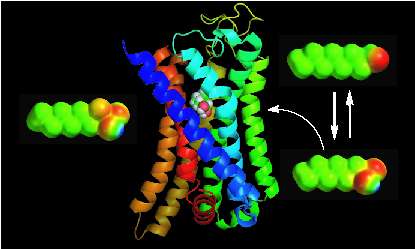Chemists discover way nose perceives common class of odors

Biologists claim that humans can perceive and distinguish a trillion different odors, but little is known about the underlying chemical processes involved. Biochemists at The City College of New York have found an unexpected chemical strategy employed by the mammalian nose to detect chemicals known as aldehydes.
According to a team led by CCNY Associate Professor of Chemistry Kevin Ryan and Columbia biologist Stuart Firestein, some of the nose's many aldehyde receptors don't detect the aldehyde by its structure and shape directly. Rather, the aldehyde is recognized by its ability to undergo a chemical reaction with water, likely after entering the nose.
Odorant receptors make up a large family of cell membrane proteins that monitor inhaled air on neurons within the nose. Aldehydes, meanwhile, are found in a variety of natural sources like herbs, flowers and fruit. They are typically fresh-smelling chemicals, and synthetic aldehydes are important to the flavor and fragrance industry.
"Once exposed to air, aldehydes have a limited lifetime as oxygen slowly converts them into less savory, even malodorous chemicals," said Professor Ryan. "It's not surprising then that the nose is adept at detecting aldehydes, and distinguishing them from structurally similar chemical groups."
His team found that for some receptors it's the aldehyde's chemical reactivity, not its inherent shape, that tells the nose there are aldehydes in the air.
In our experiments, some of the many odorant receptors that detected the eight-carbon aldehyde octanal recognized the aldehyde portion of the molecule by its ability to morph into a completely different chemical group, known as a gem-diol," he added. "Since this reaction is unique to aldehydes, it serves as a means to discriminate them from similarly shaped chemical groups."
Researchers from Duke University and Hebrew University in Israel were also involved in the study. The research at CCNY was funded by U.S. Army Research Laboratory and Office. The results will be published in the journal ACS Chemical Biology.
More information: Aldehyde recognition and discrimination by mammalian odorant receptors via functional group-specific hydration chemistry. ACS Chemical Biology, dx.doi.org/10.1021/cb400290u
Journal information: ACS Chemical Biology
Provided by City College of New York


















